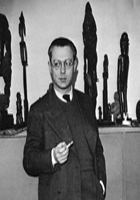Tristan Tzara
Tristan Tzara Poems
Take a newspaper.
Take some scissors.
Choose from this paper an article the length you want to make your poem.
Cut out the article.
...
two smiles meet towards
the child-wheel of my zeal
the bloody baggage of creatures
made flesh in physical legends-lives
...
Art is going to sleep for a new world to be born
"ART"-parrot word-replaced by DADA,
PLESIOSAURUS, or handkerchief
...
the fibres give in to your starry warmth
a lamp is called green and sees
carefully stepping into a season of fever
the wind has swept the rivers' magic
...
where we live the flowers of the clocks catch fire and the plumes encircle the brightness in the distant sulphur morning the cows lick the salt lilies
my son
my son
let us always shuffle through the colour of the world
...
Tristan Tzara Biography
Tristan Tzara (born Samuel or Samy Rosenstock, also known as S. Samyro; April 16 1896–December 25, 1963) was a Romanian and French avant-garde poet, essayist and performance artist. Also active as a journalist, playwright, literary and art critic, composer and film director, he was known best for being one of the founders and central figures of the anti-establishment Dada movement. Under the influence of Adrian Maniu, the adolescent Tzara became interested in Symbolism and co-founded the magazine Simbolul with Ion Vinea (with whom he also wrote experimental poetry) and painter Marcel Janco. During World War I, after briefly collaborating on Vinea's Chemarea, he joined Janco in Switzerland. There, Tzara's shows at the Cabaret Voltaire and Zunfthaus zur Waag, as well as his poetry and art manifestos, became a main feature of early Dadaism. His work represented Dada's nihilistic side, in contrast with the more moderate approach favored by Hugo Ball. After moving to Paris in 1919, Tzara, by then one of the "presidents of Dada", joined the staff of Littérature magazine, which marked the first step in the movement's evolution toward Surrealism. He was involved in the major polemics which led to Dada's split, defending his principles against André Breton and Francis Picabia, and, in Romania, against the eclectic modernism of Vinea and Janco. This personal vision on art defined his Dadaist plays The Gas Heart (1921) and Handkerchief of Clouds (1924). A forerunner of automatist techniques, Tzara eventually rallied with Breton's Surrealism, and, under its influence, wrote his celebrated utopian poem The Approximate Man. During the final part of his career, Tzara combined his humanist and anti-fascist perspective with a communist vision, joining the Republicans in the Spanish Civil War and the French Resistance during World War II, and serving a term in the National Assembly. Having spoken in favor of liberalization in the People's Republic of Hungary just before the Revolution of 1956, he distanced himself from the French Communist Party, of which he was by then a member. In 1960, he was among the intellectuals who protested against French actions in the Algerian War. Tristan Tzara was an influential author and performer, whose contribution is credited with having created a connection from Cubism and Futurism to the Beat Generation, Situationism and various currents in rock music. The friend and collaborator of many modernist figures, he was the lover of dancer Maja Kruscek in his early youth and was later married to Swedish artist and poet Greta Knutson.)
The Best Poem Of Tristan Tzara
To Make A Dadist Poem
Take a newspaper.
Take some scissors.
Choose from this paper an article the length you want to make your poem.
Cut out the article.
Next carefully cut out each of the words that make up this article and put them all in a bag.
Shake gently.
Next take out each cutting one after the other.
Copy conscientiously in the order in which they left the bag.
The poem will resemble you.
And there you are--an infinitely original author of charming sensibility, even though unappreciated by the vulgar herd.
Tristan Tzara Comments
(icniv ad odranoel ekil etirw yllutca nac i.s.p) suoisneterp ylbarebnu eb dluow ti yortsed ot tnaem t'nerew ti fi elbirret daer reve i parc fo eceip tsrow eht si siht

so few poems.. This genius needs to be more recognized!